|
|
|
THE F-106 ERA (1960 - 1983) |
|
TACTICAL AIR COMMAND (1979-1983) |
|
|
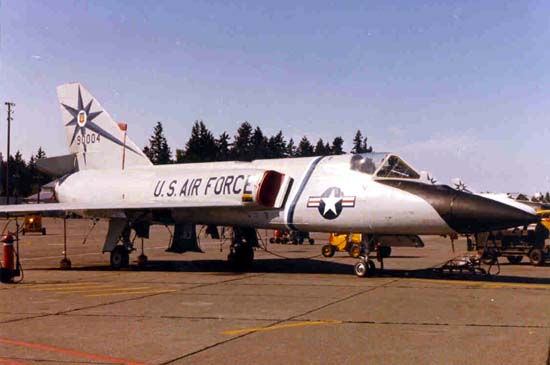 |
|
PHOTO FROM "Erv Smalley's
& Marty Isham's
Convair F-106 Delta Dart"
www.convairf-106deltadart.com/
|
|
"Balls 4" or 59-0004
wearing the three bands which composes a "Command Stripe" which
identifies the commanders aircraft. F-106 59-0004 served as the
squadrons flagship, until it was destroyed in the last crash
on 24 June 1980 - this was the last crash (Class A)
of a 318th FIS aircraft.
|
|
|
|
After a gradual
decline of the number of assigned units, the Aerospace Defense Command
inactivated on October 1, 1979 moving all of Command's
fighter-interceptor squadrons, including the 318th FIS,
Tactical Air Command (TAC). All of the former ADC
fighter-interceptor squadrons would realign under a newly created unit
in TAC, the Air Defense, Tactical Air Command (ADTAC) headquartered at
Langley AFB, VA.
For the first time in
1979, the 318th and a number of other fighter-interceptor squadrons were
invited to fly as aggressors in "Giant Voice", a Strategic Air Command
bombing competition whose mission was to improve the skills of the
Commands bomber crews. In the 1979 edition of Giant Voice, the 318th
was one of the leaders in intercepts "downing" B-52's, FB-111's, and the
British Vulcan Bomber. The 1980 competition, was a re-run of the year
before, a dominate performance by the Green Dragons. As it has done in
the past, the Green Dragons bested all competitors in the interceptor
phase of the competition by downing every bomber attempting to
penetrating their zone of defense, winning Squadron the overall and "Top
Gun" Trophies.
Fifteen minutes before
midnight on 24 June 1980, Capt. Mark "Rock" Van Stone lined his F-106A,
s/n 59-0004, towards the McChord runway after a 1 hour 25 minute
mission, suddenly a bright ball a flame was seen in the direction of the
returning F-106. Upon arriving to the scene (a wooded area two miles
south of the McChord runway), Crash Rescue crews realized their worst
fears, finding the flaming mid section of the airplane the only part
recognizable of the speedy interceptor. Van Stone, a recent addition to
the squadron fresh from an assignment flying Aggressor T-33's in Alaska, did not survive the crash. After
investigation, a rapid and sudden wind shift and problems with the bases
approach radar cold have contributed to the accident. This incident was
the last loss of a pilot or aircraft for the 318th FIS.
In January 1981,
elements of the Green Dragons flew north to Alaska's Eielson AFB to
participate in US Readiness Command's
multi-service exercise code named Brim Frost. The arctic
operation involving personnel and equipment from
active and reserve units Army, Air Force, Coast Guard, and Navy tests
the US military's ability to fight jointly in a cold weather
environment. For almost a month F-106's from the 318th protected the
aerospace above the expansive Alaskan training ranges for "Blue" force
A-10s, F-111s, and T-33s during the employment phase of Brim Frost 81.
|
|
|
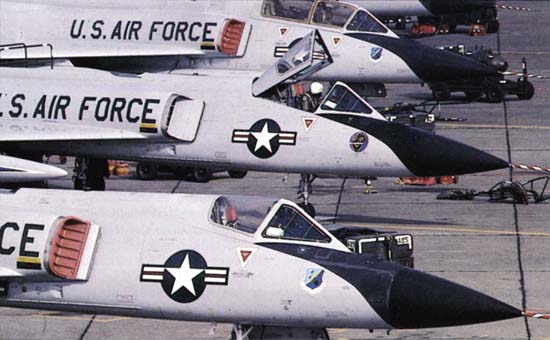 |
|
PHOTO BY STEVE FIREBAUGH - PACIFIC NORTHWEST MAGAZINE |
|
On the "Echo" ramp in front
of squadron operations, a 318th FIS pilot runs through his checklist
before the next mission. After ADCOM was absorbed by TAC, unit insignias
were moved to the nose of the F-106's, in this picture, the squadron was
in the latter stages of replacing the right side "Green Dragon" insignia
with a "ADTAC" shield.
|
|
|
|
Because of a long
overdue reconstruction/ resurfacing of busy runways at McChord, it was
necessary to temporally relocate the 318th to Fairchild AFB located in
Spokane WA. Beginning on July 9 with assistance from C-141s from the
McChord based 62d Military Airlift Wing 150 personnel and equipment
deployed to Fairchild an effort named "Delta Gambit 81" completing the
lat flight on the July. On July 13, two F-106s flying from McChord
landed at Fairchild and taxied straight into their new alert facility to
begin to perform their NORAD alert commitment. A short time 2 F-106
piloted by 318th FIS Commander Lt Col Patrick Gamble & the Squadron
Director of Operations Lt Col Norman Komnick lead 11 additional F-106 to
Fairchild marking the beginning of a 60 day deployment.
|
|
|
|
During the Fairchild
AFB deployment, it was business as usually including a two-week air-to
air combat deployment to Tyndall AFB. With runway repairs complete, the
squadron returned to McChord from September 15 through 17.
|
|
|
|
In an effort to
increase the effectiveness of F-106 squadrons across the nation, ADTAC
deactivated the Castle AFB based 84th FIS, distributing the squadron's
aircraft to the remaining F-106 squadrons. Over the next few months, a
waterfall of detachment moves would take place to cover the aerospace
once defended by the 84th. The Green Dragons alert detachment, Det. 1,
318 FIS located at Kingsley Field, OR was selected to move to Castle,
with the Oregon Air National Guard's 142d FIG/123d FIS "Redhawks"
replacing the 318th. The transfer of the 318th alert detachment was
delayed for four months to allow time for the 123d FIS's conversion from
the F-101B/F into the F-4C. As interim measure, F-106s from the
Montana ANG
stood-in for the 318th. With the Redhawks conversion complete 318th FIS
F-106A's s/n 57-0243 & 59-0147 landed at Castle
AFB, and rolled into the new home away
from home beginning their mission as the "Defenders of the Golden Gate" on 1 October 1981.
|
|
|
|
In March 1982, six
F-106s and 56 personnel deployed to Boise Air Terminal, ID in Checker
Flag '82, a exercise where Tactical Air Command units practice
deploying from their home station to a disperse location to test their
efficiently in a wartime environment. On 1 June 1982, four F-106's
flying in the William Tell Shoot-off competition topped all ADTAC F-106
squadrons and won the right to participate in William Tell 1982 after a
6-year hiatus. The 318th FIS was set to return to their last William
Tell Weapons Meet flying in the F-106.
|
|
|
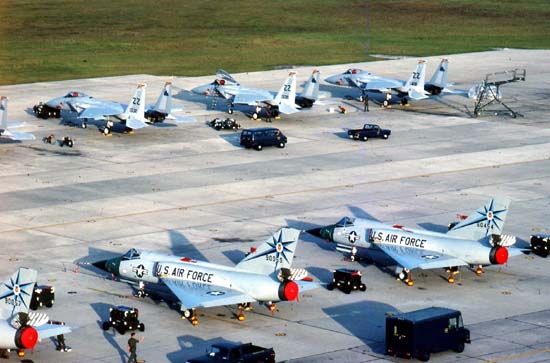 |
|
PHOTO FROM THE ernest white COLLECTION |
|
Buttoned up for the night
318th FIS F-106's are line up behind F-15Cs the eventual winners of
William Tell '82 from the 18th Tactical Fighter Wing Kadena AB, Japan.
|
|
|
|
From 15 through 21
July, the 318th interceptors participated in one of the largest live
flying exercises in North America. The exercise named Amalgam Chief was
designed to train NORAD personnel throughout the entire air defense
structure from the radar network through the frontline interceptors.
Amalgam Chief was being held in conjunction with the Strategic Air
Command's large Global Shield exercise, an operation that involved
hundreds of missiles, bombers, tankers, from across the country. During
Amalgam Chief, target aircraft acting as attackers would be detected,
tracked, and intercepted from various NORAD associated bases.
|
|
|
|
After months of
preparation, William Tell '82 began at Tyndall AFB on 8 October. In this
edition of the competition the highly touted McDonnell-Douglas F-15
Eagle made its first appearance, many thought the elderly F-106's would
not have a chance in that year's meet. With the deck stacked against
them, the 318th proved their doubters wrong. The competition started
well for the 318th as Pilot Capt Ron Dufresne made the first kill of the
competition hitting a towed target in less than 58 seconds. In the most
realistic mission (Profile IV - a "mass raid"
scenario) where four aircraft defend
a selected area from intruders (manned QF-100s, T-33s, and PQM-102
drones) entering at various altitudes, team pilots intercepted 11 of 12
aircraft.
|
|
|
|
After contributions
from pilots such as 318th Commander (and Team leader) Lt Col Pat Gamble
(flying a perfect mission), Squadron Maintenance (achieving a perfect
score) and the Weapons load team (receiving a perfect score in a record
setting time) the Green Dragons amassed a score high enough to tie the
Competitions top Squadron (flying F-15's) for the lead. On the Green
Dragon final mission at William Tell 82, everything that could go wrong
did go wrong.
|
|
|
|
During make-up flights
for "Profile II", random missiles issued to the squadron failed to
"lock-on" to their targets - no score for the 318th. On the next day one
another make up flight for "Profile III" started off on badly with
one of the squadrons F-106's failed to start leading to a "ground
abort", after 4 318th F-106s reach the air only the backup pilot
achieved a "hit" and score. By the end of the day the 318th found itself
in in 9th place (out of 13) finishing second in the F-106 category.
|
|
|
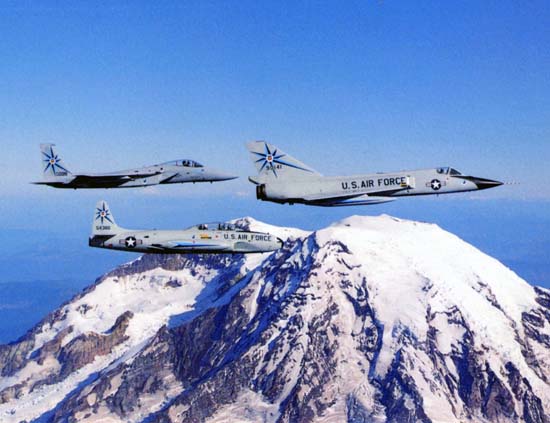 |
|
PHOTO FROM "F-15 EAGLE" BY ROY BRAYBROOK |
|
About two months before her
last flight with the 318th F-106 (s/n 59-0141) is pictured with the one
of the newly arrived F-15As (s/n 76-0098) and a T-33A (s/n
55-4386) in this photo-op by Mt Rainer.
|
|
|
|
From August 1 through
21st, the 318th was back at Tyndall AFB in their highly successful
weapons and Air Combat Maneuvering Instrumentation (ACMI) deployment. In
"Combat Pike", the squadron annually tests each of its F-106s capability
to fire live weapons as well as providing realistic training in a combat
environment in Tyndall's ACMI range.
|
|
|
|
After many year of
debate over a replacement for the trusty F-106, the USAF selected the
F-15 Eagle over the Grumman F-14 Tomcat as the next interceptor for
TAC's interceptor squadrons. The first fighter-interceptor squadron
selected to receive the F-15 was the 48th FIS at
Langley,
VA, receiving their first aircraft
in 1982, the second squadron was to be the 318th in the following year.
|
|
|
|
With the arrival of
their first F-15 weeks away, the 318th FIS lost its first F-106, S/N
59-0057, to the "Boneyard" at Davis-Monthan AFB, AZ on 1 June 1983.
F-106A -057 was a squadron veteran, having been stationed with the 318th
all of its 23 years on Active duty. The rain that day set the mood of
the squadron, -057 seemed to know what was in her future as the pilot
Capt. Tim Murphy, failed to get the trusty interceptor started. After
the powerful J-75 engine of the F-106 started, Capt Murphy taxied the
fighter by lines of 318th FIS members paying their last respects,
moments later -057 lifted off the McChord runway for the last time.
|
|
|
|
On 10 June 1983, a
large crowd of onlookers witnessed the changing of the guard of the air
defense. In a symbolic passing of the torch, two F-106s escorted the
first of 24 McDonnell Douglas F-15's (F-15B S/N 76-0141) to be assigned
to the 318th FIS. On the second pass over the crowd, the F-15 flew in
the lead position, assuming the role as "Defender of the Great
Northwest" at McChord and the "Defenders of the Golden Gate" at Castle AFB, CA.
|
|
|
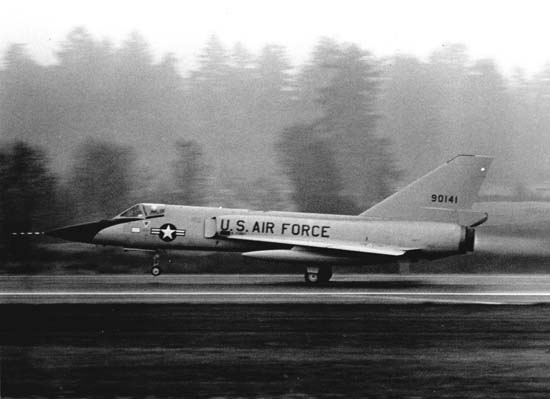 |
|
PHOTO BY FRED JOHNSON - McCHORD
AIR MUSEUM |
|
With her 318th FIS
markings removed s/n59-0141, takes off from McChord for the final time
as the 20th F-106 retired to the Arizona desert. Unlike many of the
other 318th F-106s -0141 would not be acquired by another squadron, she
would spend 8 years in storage before being the 134 F-106 converted into
a full-sized target drone in 1991. Over the next 17 months -0141 would
fly 5 unmanned missions, before being shot down by a
shoulder fired Stinger Missile.
|
|
|
|
During the busy
conversion, the squadron was expected to run as normal, that test was
under way in early July. About every 18 months US Air Force units level
of readiness is tested in what is known as a Operational Readiness
Inspection or ORI - no exceptions for units undergoing conversions, but
this fact was not an issue, the 318th did very well under the pressure
of inspection teams.
|
|
|
|
On 4 November 1983,
318th pilot Lt. Col. Peter Bracci flew McChord's last F-106 (S/N
59-0141) to the Arizona military aircraft "Boneyard". After
delivery, Lt Col Bracci would move to Det. 1, 5th FIS at Davis Monthan. About
two-thirds of the squadron, including the Commander Lt Col Gamble, would
leave the squadron to other squadrons either F-106s or other aircraft
they would be replaced by trained F-15 personnel the remaining one-third
would retrain into the F-15.
|
|
|
|
As a symbol to the
importance the Delta Dart has played in the history of McChord, the
318th presented the McChord Air
Museum with an F-106; s/n
56-0459 formerly involved in the types World Speed Record in 1959. In a
13 December 1983 ceremony, new Squadron Commander Lt Col Gordie Breault
and -0459's last pilot Capt Randy Neville and last Crew Chief
Amahad McGee presented the freshly painted F-106 to Museum Air Museum
Administrator Fred Johnson.
|
|
|
|
Next
page: The F-15 Era (1983 - 1989) |
|
|
|
|
 |